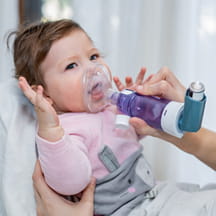As the surge of respiratory illnesses strains children’s hospitals across the nation, one of the primary challenges is finding enough beds to accommodate the oncoming waves of sick children. Hospitals in Maryland are leveraging a pandemic-inspired critical care transfer system to help match severely ill children with the care they need.
The Maryland Institute for Emergency Medical Services Systems (MIEMSS) created the Critical Care Coordination Center (C4) to facilitate critical care transfers during the pandemic. Launched in late 2020, C4 is staffed by physicians and critical care coordinators to help health care providers across Maryland identify available critical care resources and facilitate necessary patient transfers. Though the system was originally built to aid hospitals struggling with COVID-related adult patient admissions, the state launched a pediatric component to C4 in October 2021. That decision—and the several months of lead time it afforded C4 administrators to fine-tune the system prior to the 2022 respiratory virus surge—proved to be a godsend.
“Thank goodness we had the staff in place, so when people needed us we were ready to immediately step up and help get kids moved into the care they needed,” says Jennifer Anders, M.D., medical director of the C4 Pediatrics program at MIEMSS, and pediatric base station medical director and pediatric emergency medicine physician at Johns Hopkins Children's Center in Baltimore.
Improved triage decisions and fewer phone calls
Since its inception, C4 has helped about 50 pediatric health care providers find critical care transfers for more than 1,300 patients to facilities across Maryland, as well as surrounding states and the District of Columbia. It’s not only helped health care institutions balance patient loads during the respiratory virus surge but has freed clinicians on both sides of the patient transfer equation from the time-consuming task of facilitating transfers themselves via phone calls—time that could be spent with their patients.
But the program provides other benefits beyond directing patient traffic. Perhaps one of the most important is the program’s goal to improve the overall quality of critical and pediatric care by establishing quality improvement initiatives, including the standardization of patient care and use of technology and data gathering. Not only do these shared best practices ensure the highest-quality care for the patients, they also enable C4 to quickly ascertain those with the most critical needs.
“C4 created a common language where there wasn't one and where there desperately needed to be one,” Anders says. “When we're working to triage patients and transfer them between hospitals and trying to determine which baby is the sickest and needs a bed the soonest, speaking a common language and having a common way to assess them is really critical.”
Lessons for other hospitals
The investments of time and resources by all participating institutions has greatly contributed to C4’s success, according to Anders. But she says children’s hospitals in other areas of the country can still apply some of the same principles now to address the current respiratory virus surge.
“A lot of what we do can be done with existing people and infrastructure and probably not a lot of cost investment,” Anders says. “In places where there are a handful of centers willing and able to work cooperatively, the same things can apply.”
Among the key learnings for C4 was the importance of a shared real-time list of facility capacities and knowledge of where the most critically ill children in the region are awaiting an open bed. “It's important that everyone has the perspective of where the sickest kids are and that we get the beds to the kids who need them so that we prevent any bad outcomes,” Anders says.



